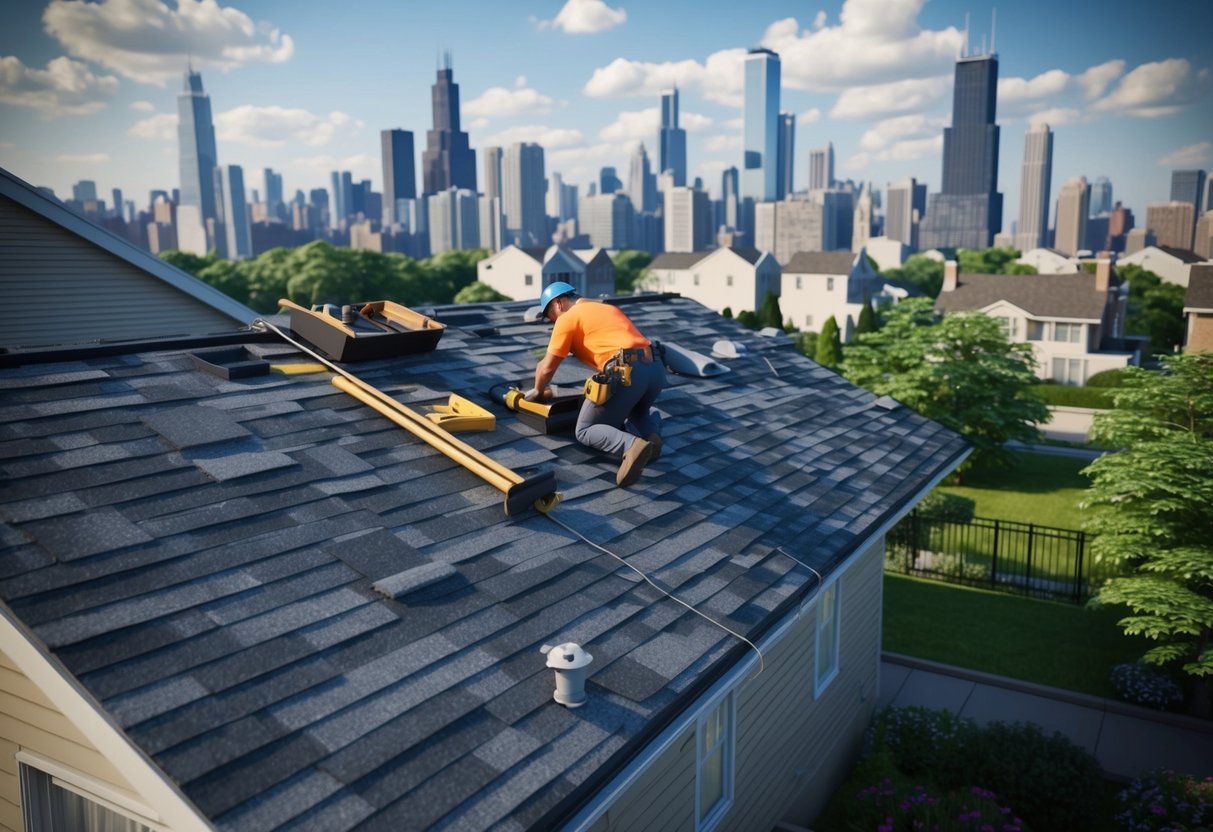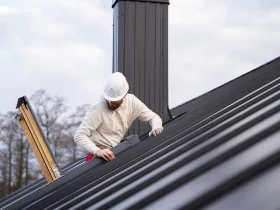Many people in Chicago don’t know that commercial roofers often do residential roof repairs too. This fact might surprise homeowners who need their roofs fixed.
Commercial roofers have skills that work well for homes. These pros can handle both big and small jobs, making them a good choice for fixing house roofs in Chicago. They know how to work with different types of roofing materials and can spot problems quickly.
Chicago’s weather can be tough on roofs. Snow, rain, and wind cause damage that needs fixing. Commercial roofers are used to working in all kinds of weather. This means they can help homeowners keep their roofs in good shape year-round. They offer services like leak repairs, shingle replacement, and full roof installations for houses.
The Role of Commercial Roofers in Residential Repairs
Commercial roofers often handle residential roof repairs in Chicago. Their skills and experience make them well-suited for a wide range of roofing projects.
Comparing Commercial and Residential Roofing Services
Commercial roofers work on large, flat roofs with complex systems. Residential roofers focus on sloped roofs for homes. Commercial roofers handle more complex projects and use different materials than residential roofers.
Commercial roofing jobs often involve:
- Larger roof areas
- Heavy equipment
- Specialized materials like TPO
Residential roofing typically includes:
- Asphalt shingles
- Smaller roof areas
- Simpler designs
Both types of roofers need to work safely at heights. Commercial roofers are used to strict safety rules on big job sites. This makes them careful on home roofing jobs too.
Why Commercial Roofers are Suited for Residential Projects
Commercial roofers bring unique skills to home roof repairs. They are used to working on tough jobs in all weather. This helps them fix tricky leaks and damage on house roofs.
Commercial roofers know how to use special tools for sealing leaks and fixing damage. They can apply these skills to home roof repairs. Their experience with different roofing materials is useful for fixing various types of residential roofs.
These roofers are good at solving complex problems. A small leak in a home’s roof can lead to big issues if not fixed right. Commercial roofers know how to spot and fix these problems fast.
Types of Roofing Systems and Materials
Commercial roofers work with a variety of roofing systems and materials. Each option has unique benefits and drawbacks for different building types and climates.
Metal vs Asphalt Shingle Roofing
Metal roofs are durable and long-lasting. They can withstand harsh weather and last 50+ years. Metal roofing is fire-resistant and energy-efficient. It reflects sunlight, helping lower cooling costs.
Asphalt shingle roofs are becoming more common for homes. They’re affordable and easy to install, and the roofs typically last 20-50 years. Shingles come in many colors and styles to match different house designs.
Metal roofs cost more upfront but need less maintenance. Shingle roofs are cheaper but may need repairs sooner. Climate and budget often guide the choice between metal and asphalt shingles.
Flat Roof and Single-Ply Roofing Options
Flat roofs are common on commercial buildings. They use different materials than sloped roofs. Single-ply roofing is a popular flat roof option.
TPO and EPDM are two main types of single-ply roofing. TPO is white and reflects heat well. EPDM is black and absorbs heat. Both are durable and resist leaks.
PVC is another single-ply choice. It’s strong and resists chemicals. These materials come in large sheets. Roofers weld or glue the seams to create a watertight surface. When dealing with many residential and commercial buildings, you usually need TPO roofers in Chicago.
Innovations in Roofing Materials
New roofing materials offer improved performance. Cool roofs reflect more sunlight. This helps buildings stay cooler and use less energy. Some cool roofs use special coatings or light-colored materials.
Green roofs are gaining popularity. They have plants growing on top. Green roofs provide insulation and manage rainwater. They also create habitat for wildlife in urban areas.
Solar tiles blend in with regular roofing. They generate electricity while protecting the building. As technology improves, these options become more efficient and affordable.
Roof Damage and Repair Necessities
Roof damage can happen for many reasons. It’s key to spot issues early and fix them fast. This helps avoid bigger problems later on.
Identifying Common Roof Issues
Roof leaks are a common problem. They can start small but get worse quickly. Signs of leaks include water stains on ceilings or walls.
Missing or damaged shingles are another issue to watch for. These leave the roof open to more damage.
Cracks in flashing can also cause trouble. Flashing is the metal that seals roof joints. When it cracks, water can get in.
Regular checks can catch these problems early. This makes fixes easier and cheaper.
Impacts of Hail and Storm Damage
Hail damage can be serious. It can create dents or holes in roofing materials. This weakens the roof’s ability to protect the building.
Strong winds from storms can tear off shingles or roofing panels. This leaves the roof exposed to further harm.
Heavy rain can test a roof’s ability to drain water. If drains are blocked, water can pool and cause leaks.
After a storm, it’s smart to have a pro check the roof. They can spot damage that’s hard to see from the ground.
Quick action and knowing what to do when you have storm damage can prevent bigger issues. It helps keep the building safe and dry.
Understanding the Roofing Project Lifecycle
A roofing project involves several key stages from start to finish. These steps ensure a well-executed job that protects buildings for years to come.
From Inspection to Maintenance
The roofing project lifecycle begins with a thorough roof inspection. Professionals check for damage, leaks, and wear. This assessment helps determine if repairs or a full replacement is needed.
For new roof installations, the process starts with removing old materials. Workers then prepare the surface and install new roofing components. This includes underlayment, shingles or other coverings, and flashing.
Roof replacements follow a similar pattern. The team removes the existing roof completely before installing the new one. This allows for fixing any underlying issues.
After installation, regular maintenance is crucial. It includes cleaning gutters, checking for loose shingles, and addressing minor repairs promptly. These steps help extend the roof’s lifespan.
Periodic roof inspections should occur every 1-2 years. They catch problems early and prevent costly damage. Professional roofers look for signs of wear, water damage, and structural issues.
Financial Considerations and Insurance
Roof repairs and replacements can be expensive. It’s important to understand costs and insurance coverage before starting a project.
Estimating Roof Repair and Replacement Costs
Roof repair costs vary based on the damage and materials needed. Minor fixes may cost a few hundred dollars, while major repairs can run into thousands.
Replacement costs depend on roof size, material choice, and labor. Asphalt shingles are usually cheaper than metal roofing. Labor costs make up a big part of the total price.
Most roofing companies offer free estimates. It’s smart to get quotes from 3-4 contractors to compare prices. Be wary of extremely low bids, as they may indicate poor quality work.
Navigating Roofing Insurance Claims
Many homeowners insurance policies cover roof damage from storms or accidents. It’s key to understand what’s covered before filing a claim.
Steps for filing a claim:
- Document the damage with photos
- Contact the insurance company promptly
- Schedule an inspection with an adjuster
- Get repair estimates from licensed roofers
- Review the claim decision and payout offer
Some insurers may deny claims for older roofs or normal wear and tear. In these cases, homeowners may need to pay out of pocket for repairs or replacement.
Working with roofers experienced in insurance claims can help navigate the process. They can spot all damage and ensure fair compensation.
Ensuring Quality and Satisfaction
Quality roofing work and customer satisfaction go hand in hand. Reputable roofers offer guarantees and stand behind their work. This builds trust and ensures long-lasting results for homeowners.
Selecting Reputable Roofers for Your Needs
Choosing the right roofer is key for quality repairs. Look for experienced roofing contractors with good reviews and proper licensing. Ask about their training and certifications.
Check if they use high-quality materials from trusted brands. Reputable companies often partner with manufacturers like Owens Corning or GAF.
Get detailed written estimates from multiple roofers. Compare their offerings and ask questions about their process. A good contractor will explain things clearly and address your concerns.
Verify insurance coverage to protect yourself from liability. Ask for references and examples of past work similar to your project.
Guaranteeing Work Through Warranty
Warranties provide peace of mind for homeowners. Most reputable roofing companies offer warranties on both materials and labor.
Material warranties typically range from 20 to 50 years. They cover defects in the roofing products themselves.
Labor warranties protect against installation errors. These usually last 5-10 years, but some companies offer longer terms.
Read warranty terms carefully. Understand what’s covered and any maintenance requirements. Some warranties are prorated, while others offer full replacement value.
Many roofers also provide a satisfaction guarantee. This shows their commitment to quality work and customer happiness.
Additional Roofing Services and Enhancements
Roofing professionals offer more than just repairs and replacements. They provide a range of services to protect and enhance roof performance.
The Benefits of Roof Coatings and Waterproofing
Roof coatings extend the life of roofing systems. They create a protective layer that shields against UV rays, rain, and temperature changes.
Coatings come in different types:
- Acrylic
- Silicone
- Polyurethane
These products can lower energy costs by reflecting sunlight. They also stop leaks and prevent water damage.
Waterproofing is crucial for flat roofs. It involves applying special membranes or liquid coatings. This extra layer keeps water out and protects the building structure.
Professional roofers can assess which coating or waterproofing method works best for each roof.
Understanding the Importance of Gutter Systems
Gutters play a key role in roof health. They channel water away from the building’s foundation, which prevents water damage and soil erosion.
A well-designed gutter system includes:
- Properly sized gutters
- Downspouts
- Splash blocks or extensions
Regular gutter cleaning is essential. Clogged gutters can cause water to back up under shingles, which leads to roof leaks and damage.
Experienced roofers can install, repair, and maintain gutter systems. They ensure proper slope and secure fastening. Some offer gutter guards to reduce debris buildup.
Gutter maintenance often includes flashing repair. Flashing seals roof edges and prevents water intrusion around chimneys and vents.




